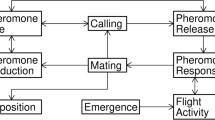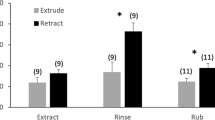Abstract
The upwind flight of male moths to conspecific females is mediated by the chemical and structural characteristics of a pheromone plume. We describe the reaction of maleCadra cautella, the almond moth, to the interception of single pulses of sex pheromone, the smallest structural units of odour plumes. Following loss of a pheromone plume, males cast, that is fly a crosswind course without progressing upwind. The response of casting males to interception of a pulse of 0.25 s duration was, after a delay of 0.21±0.07 s, to turn and briefly fly straighter upwind, resulting in average net upwind displacements of 18 cm in a 50 cm s−1 wind. Upwind progress in the single-pulse response was the result of steering more upwind and an increase in airspeed, although average ground speed remained unchanged. During the last third of the surge, males turned crosswind, returning to casting flight. These behavioural reactions to pheromone contact and loss support the phasic-tonic model of odour-modulated flight, in which an underlying tonic counterturning rhythm, expressed upon pheromone loss, is briefly overridden by phasic upwind surges, expressed upon interception of the pheromone filament. The surge portion of the cast-surge-cast response was diminished and more crosswind if individual pulses were shorter (0.02 s), probably due to ‘sub-optimal’ contact with pheromone. The cast-surge-cast response to interception of a single 0.25 s pulse was used as a template to interpret the form of flight tracks in plumes of known structure. The template matched portions of flight tracks of males flying in plumes of low pheromone pulse frequency, thus reflecting the male's pattern of pulse encounter. In plumes ensuring a high frequency of pulse interception, only the upwind surge portion of the template was expressed, resulting in nearly straight upwind flight tracks. Similar nearly straight upwind flight tracks occurred in flights along plumes of low pulse frequency with large volume. Thus flight tracks of maleC. cautella to point sources of pheromone depend on both the frequency and the size of filaments encountered.
Similar content being viewed by others
References
Murlis, J., and Jones, C. D., Physiol. Ent.6 (1981) 71.
Murlis, J., Elkinton, J. S., and Cardé, R. T., A. Rev. Ent.37 (1992) 505.
Kennedy, J. S., Physiol. Ent.8 (1983) 109.
Marsh, D., Kennedy, J. S., and Ludlow, A. R., Physiol. Ent.3 (1978) 221.
Ludlow, A. R., Ph.D. thesis, University of London 1984.
Zanen, P. O., Ph.D. thesis, University of Massachusetts, Amherst 1993.
Kuenen, L. P. S., and Baker, T. C., Physiol. Ent.7 (1982) 423.
Mafra-Neto, A., and Cardé, R. T., Nature, Lond.369 (1994) 142.
Mafra-Neto, A., and Cardé, R. T., Physiol. Ent.20 (in press) (1995).
Vickers, N. J., and Baker, T. C., Proc. natl. Acad. Sci. USA91 (1994) 5756.
Kuenen, L. P. S., and Cardé, R. T., Physiol. Ent.19 (1994) 15.
Baker, T. C., Proc. Tenth Intl Symp. Olfaction Taste, p. 18. Ed. K. B. Doving. Graphic Communication Systems, Oslo 1990.
Mafra-Neto, A. Ph.D. thesis, University of Massachusetts, Amherst 1993.
David, C. T., in Mechanisms in Insect Olfaction, p. 49. Ed. T. L. Payne, M. C. Birch and C. E. J. Kennedy. Clarendon Press 1986.
Mafra-Neto, A., and Cardé, R. T. Physiol. Ent. (in press) (1995).
Charlton, R. E., Kanno, H., Collins, R. D., and Cardé, R. T., Physiol. Ent.18 (1993) 349.
Willis, M. A., and Baker, T. C., Physiol. Ent.9 (1984) 341.
Willis, M. A., and Cardé, R. T., J. comp Physiol. A167 (1990) 699.
Christensen, T. A., and Hildebrand, J. G., Chemical Senses13 (1988) 123.
Vickers, N. J., and Baker, T. C., J. Insect Behav.5 (1992) 699.
Author information
Authors and Affiliations
Rights and permissions
About this article
Cite this article
Mafra-Neto, A., Cardé, R.T. Dissection of the pheromone-modulated flight of moths using single-pulse response as a template. Experientia 52, 373–379 (1996). https://doi.org/10.1007/BF01919543
Received:
Accepted:
Published:
Issue Date:
DOI: https://doi.org/10.1007/BF01919543




